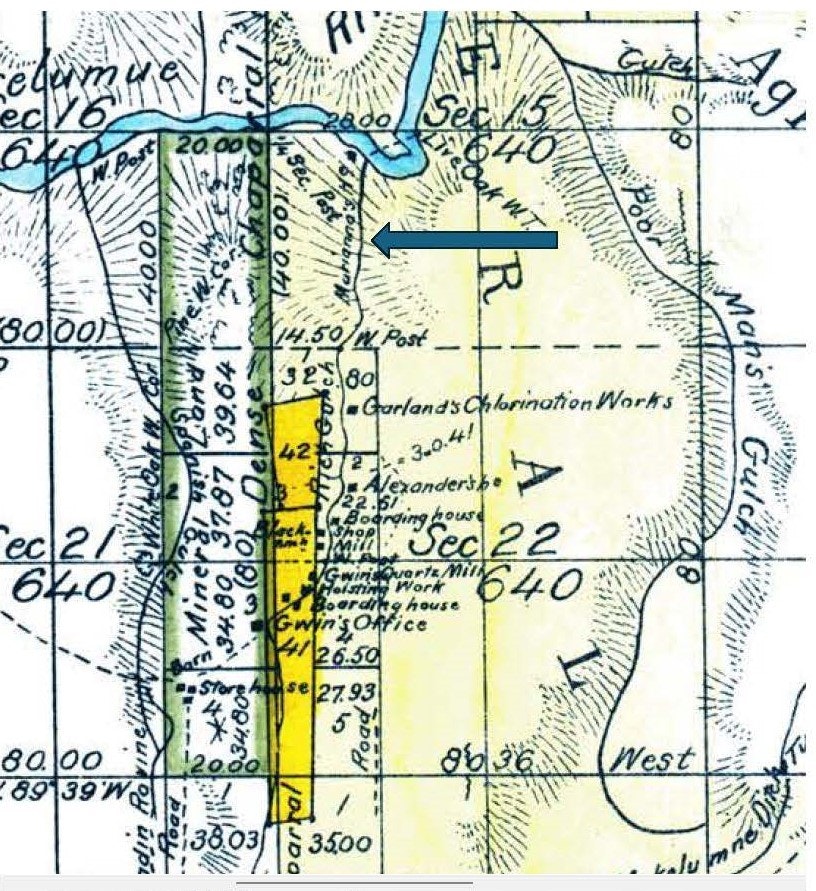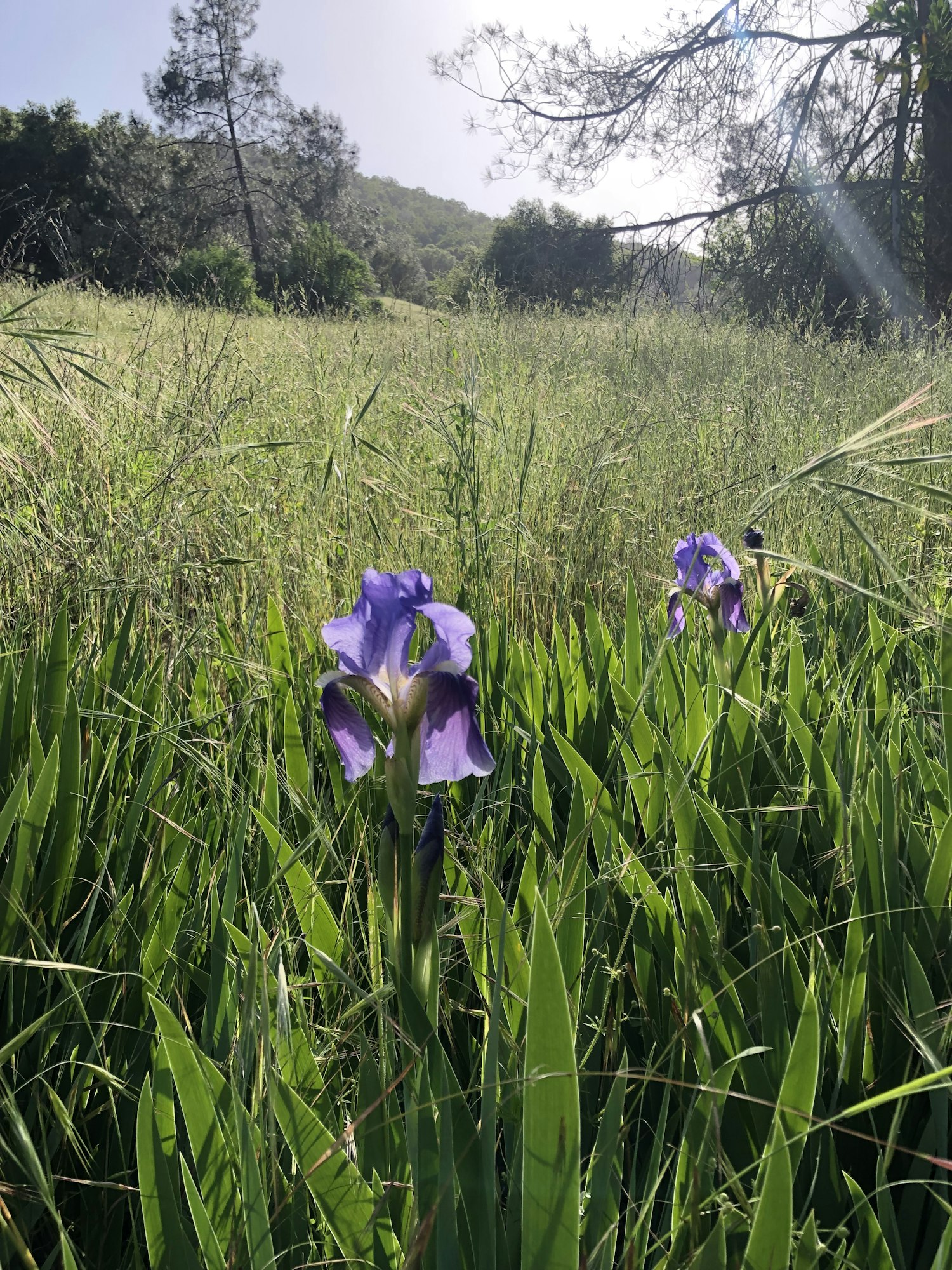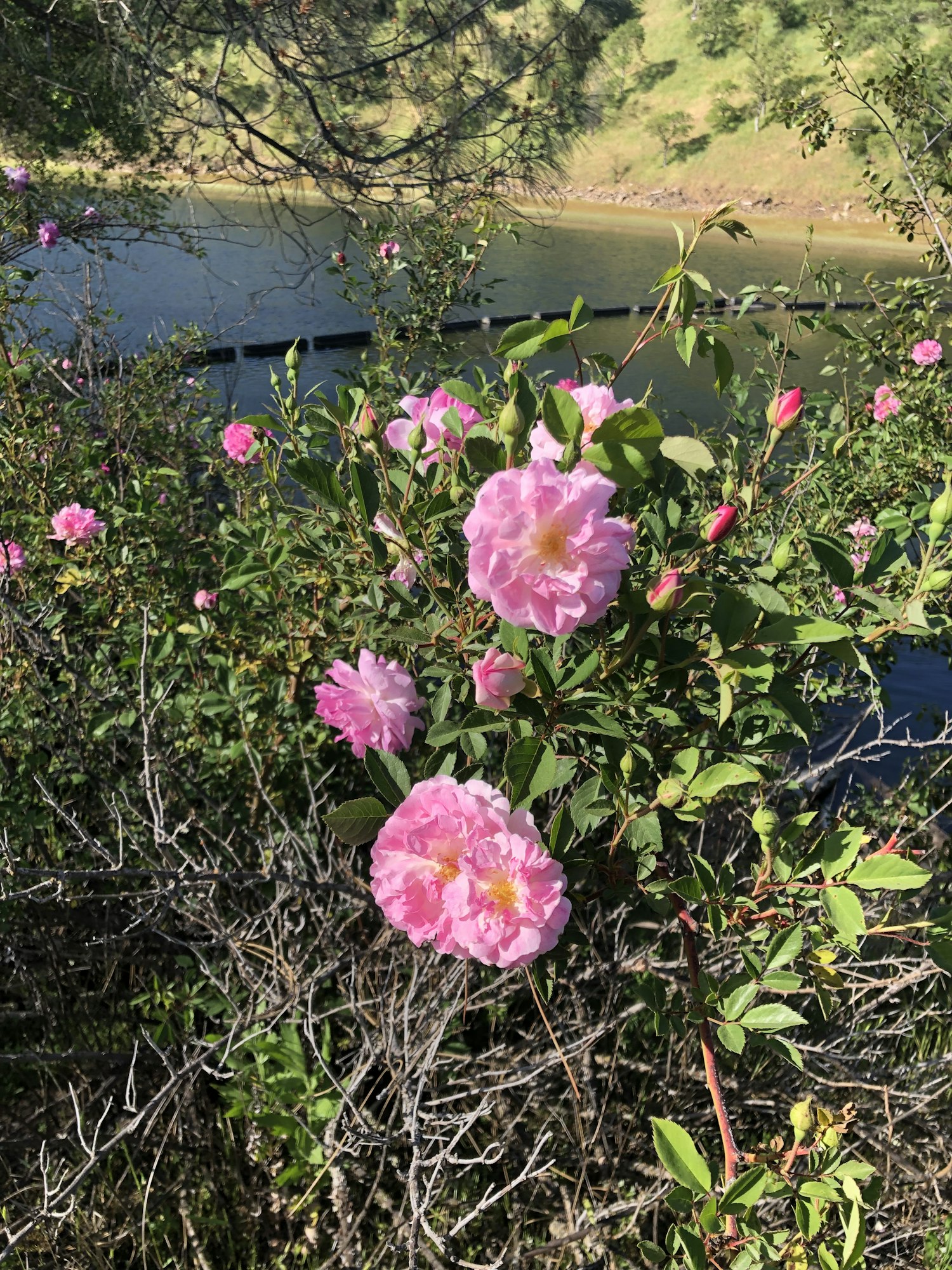James Bar/Lower Bar
The Italian Ranch at James Bar
By Shannon Van Zant and Julia Costello (24 April 2025)
At the bottom of Gwin Mine Road, leading to the Mokelumne River from the community of Paloma in Calaveras County, is East Bay Municipal Utility District’s (MUD) trailhead to Patti’s Point. From the parking area, it continues down Rich Gulch to the river before turning west up the steep trail to the lookout. Most hikers pass by the confluence of Rich Gulch and the Mokelumne without noting the complex of well-stacked terrace walls along the bank; an impressively large, stone-lined cellar and yard; remains of outbuildings; and surviving domestic plants. This was once known as the “Italian Ranch,” established by Mariana Patti and his wife in the 1850s, and continued under the Chuma family into the 1920s.

The Italian Ranch was near a popular Gold Rush site called James Bar. First identified as Lower Bar (Big Bar and Middle Bar are further upstream), the location was famously rich in gold. The perennial creek of Rich Gulch carried nuggets and flakes down to join the placer deposits of the Mokelumne at this bend in the river. Bayard Taylor describes the diggings in 1849 and made a fine sketch depicting panning prospectors and the miners’ camp.
Mariana (Marianna, Mariano) Patti was born in Sicily in 1812. His wife (whose name we do not know) came from Montevideo, a small village outside Venice in northeast Italy. Marrying by 1850, their first child, William, was born in California in 1851. Perhaps initially drawn to the riches of James Bar, they turned instead to ranching and farming. In March 1856, Mariana filed his claim for 160 acres along the banks of the Mokelumne River, encompassing the lower reaches of Rich Gulch and lands stretching east and west. The following year he was taxed for improvements at the ranch and in 1858 his holdings were valued at $400, along with “two Spanish horses” worth $100. A map of 1855 shows a series of structures along Mariana’s river frontage.
The Patti family grew. In quick succession, Anna (1855), Mary Bell (1857), Victor (1858), and Antone (1859) were added to the household. Sometime after Antone was born, Mrs. Patti apparently died, as the 1870 census lists only Mariana and the five children; no additional births are recorded. In this roll, Mariana, age 56, is identified as a “gardener.” He is a US citizen with real estate valued at $400 and personal property at $1,000. William (age 19), Anna (15), Mary Bell (13), Victor (12), and Antone (11) were all living at home, the oldest three attending the Middle Bar school within the year.

The homestead was not as isolated as it is now. It was located just a mile below Middle Bar, a thriving community at this busy river crossing. Until 1856, the main road from Mokelumne Hill to Jackson and Sacramento crossed here by ferry. In 1856, Dr. L. Soher constructed a bridge at Big Bar (the current route of Highway 49) along with a new toll road from Mokelumne Hill with a gentler grade. With these improvements, traffic shifted upriver and Middle Bar was sidelined. A small community persisted there, however, with the Sargent, Bales, Boitano, and Sanguinetti families remaining. Other ranches along the river, including the Garavanta family on the Calaveras side, made up a rich Italian community.
An assessment for the Italian Ranch in 1873-74 itemizes a house, barn, fence, orchard, and vineyard along with horses, cows, goats, a mule, hogs, wine, and poultry valued at $333. The surveyor for the Government Land Office, when laying out section lines, was so impressed with the ranch, he specifically identifies “Marianna’s House” on his official map of 1872. In his survey notes he reports that Mariana claims to also own “considerable” land across the river. Most ranchers and farmers kept a hand in mining and Patti also owned the Washington quartz claim, which he would typically work in his spare time.

The success of the Italian Ranch was influenced by the fortunes of mining developments in adjacent Rich Gulch. The rich quartz ledge was discovered by 1850, and in the early 1860s warranted a 24-stamp mill. These workings attracted the attention of Senator William M. Gwin who acquired the Paloma claim in 1867 and the Alexander mines in 1872. The profitable operation was capably managed by his son, William M. Gwin Jr., who saw the addition of a 32-stamp mill. During these years, produce from the Patti ranch would have found a ready market supporting the mining workforce.
Around 1875, the two Patti daughters married. Anna (age 19) to miner James Podesta (age 27) and Mary Bell (age 17) to miner Joseph Morache (age 31). Both wed men born in Italy, attesting to the strong bonds of this close-knit, immigrant community. In April 1879, patriarch Mariana Patti died at age 67. His probate identifies four children, omitting William who presumably died. Mariana’s itemized estate reveals the success of this pioneering Italian family:
· 160 acres of land; approximately 30 acres in vineyard
· A ditch conveying water to this ground
· A dwelling house, barn, and other outhouses.
· 1 stove and household furniture
· Livestock: 7 cows and 4 calves, 2 yearlings, 1 bull, 2 steers, 2 horses, 1 mule, and harnesses
· 8 tons of hay; 1 plow
· About 2,000 split pickets (for fencing); 500 feet of lumber
The Italian Ranch was sold to Paul Chuma and the following year, 1880, the two youngest sons, Victor (age 21) and Antone (age 20), are recorded as living with their older sister Anna Patti Podesta. Victor died in 1881 of tuberculosis consumption and is buried next to his father in the Mokelumne Hill Protestant Cemetery. The newspaper account of his death suggests the Podesta family may have continued living on the Italian Ranch with the Chumas:
Victor Patti, a young man 21 years of age who has lived with his folks near the Gwin Mine for many years, died in this place… “ (Calaveras Weekley Citizen 29 Oct 1881)
The youngest Patti son, Antone, worked for a time as a miner but his life ended in San Quentin prison. In 1892, he was sentenced to 14 years for shooting and badly wounding Mabel Wheeler while drunk in Copperopolis. He died in San Quentin in 1897 at age 38.
Paul Chuma (Ciouma) purchased the Italian Ranch and the Washington Claim from Patti’s estate for $900. Paul had immigrated to the US in 1870 at age 35 and apparently prospered as he could afford the purchase price. Identified as coming from Austria, he was likely he was likely from Lombardy or Veneto Provence -- then claimed by Austria -- as he easily joined the local Italian community. The Chumas’ may have known Mrs. Patti’s family who's hometown was in Veneto. In about 1880, at age 45, he married Angelina Quirolo (age 32) who had arrived from Italy in 1878. The newlyweds settled on the ranch and began to grow their family. Mary was the first, born in 1882, followed by Marco (1884), John (1887), Emil (1889), and George (1894). In 1888, the Chumas’ were assessed for their 160 acres ($200); a house, barn, and fence, ($280); and personal property of harness, a horse, a cow, a hog, hay, furniture, poultry, and a dog ($138).
Profitable mining in Rich Gulch ended in 1882 when the Gwin family decided not to invest additional money and closed the operation. In 1893, however, accomplished mining engineer Frederick F. Thomas (who had revitalized the Kennedy mine in Jackson), resurrected the mine, aided by manager David McClure. Incorporating the Gwin Mine Development Company with friends and associates, it became one of the largest producers in the county. They sunk new deep shafts, expanded underground workings, constructed a new 40-stamp mill, and employed some 50 to 90 men working double shifts. The Gwin mine was admired for its high profit margin and excellent employee relations. In this success, the Chuma family saw an opportunity for diversification by opening a saloon.
In the 1898 assessments, in addition to two houses, a barn, shed, and fencing, Paul Chuma is newly assessed for a “saloon building,” and in the 1900 census Paul is identified as a “Saloon Keeper.” Living on the ranch at this time are Paul (55) and Angela (52) along with their children Mary (19), Mark (17), John (14), Emil (12), and George (6). Mary is identified as a “servant” and Mark as a “vaquero;” the other children attended school in Middle Bar. Tragically, young John died the following year when he fell from a horse, and 19-year-old Mark died in 1902 in an accident at Gwin Mine.
The Gwin Mine Development Company closed the mine in 1908, for reasons apparently based on company management issues. This resulted in the general abandonment of the nearby town of Paloma and closure of the small Middle Bar grade school. Although certainly suffering some loss of revenue from their saloon, the Chuma family survived. They continued working the ranch until 1920 when Paul died at age 75. In 1928, the family sold the Italian Ranch to East Bay MUD and the following year the still waters of Pardee Reservoir lapped the banks below the old homestead.
Chuma descendants continued to live in the area. Son George owned a bottle shop on Main Street in Jackson for many years and died in San Joaquin County in 1969. Emil served in World War I and died in 1972 in Jackson. The eldest Chuma sibling, Mary, outlived them all. She married Angelo Boitano from a Middle Bar family and died in 1983 at age 101.
What survives of the Italian Ranch are now archaeological treasures owned and managed by East Bay MUD. Visitors can carefully peer down into the large, stone-lined basement where gallons of wine were produced, marvel at the extensive terracing along Rich Gulch, and identify imprints of the barn and other outbuildings along the hiking trail. And, if they come at the right time in spring, they can see in bloom the tall, light-blue iris and pink roses adjacent to the old homestead.


References
Calaveras County Documents:
Criminal files
Death notices,
Property Tax Assessments,
Probate
Newspaper accounts
U.S. Census Reposts
Clark, William B.
1991 Gold Districts of California. Bulletin 193. California Division of Mines
and Geology. California State Printing Office. Sacramento.
Fuller, Willard P. Jr.
1968 The Gwin Mine at Paloma. Las Calaveras. Vol.16, No. 2, pp 5-12.
Limbaugh, Ronald H, and Willard P. Fuller Jr.
2004 Calaveras Gold: The Impact of Mining on a Mother Lode County. University of Nevada Press, Reno.
Taylor, Bayard
1850 El Dorado: Adventures in the Path of Empire. G.P. Putnam’s Sons, New York.
